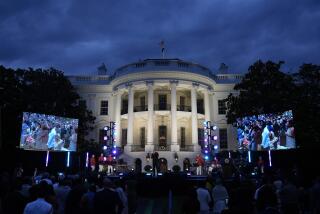Congress Plagued by Special Days : Legislation: Some lawmakers think that proclaiming numerous commemorative periods is a waste of time, money. Reforms are proposed.
- Share via
WASHINGTON — National Asparagus Month, National Dairy Goat Awareness Week and National Prune Day are typical national commemoratives--days, weeks, months or even years that are recognized by the government to honor various people, events and causes. And all, in the eyes of some lawmakers, are superfluous, expensive and ripe for reform.
“If we spent as much time on serious efforts to balance the budget, reform the nation’s health-care system or target U.S. investment in Eastern Europe, there’s no telling how much further along we would be in finding answers to the real problems that face us instead of worrying about which farm animal we are going to honor next week,” Rep. Alex McMillan (R-N.C.) observed.
Commemorative bills vary from public service observances such as Historically Black College Week and Literacy Day to less lofty undertakings like National Tap Dance Day and National Mule Day.
The first commemorative--Mother’s Day--was approved by Congress in 1914. It was 14 years before another observance, Child Health Care Day, passed commemorative muster. In those days, Congress showed considerable restraint in proclaiming events worthy of national recognition.
Seventy years later, however, the 100th Congress approved the largest volume of commemorative legislation ever--258 resolutions; 38% of all measures enacted in 1987 and 1988, were commemorative in nature.
At its present pace, the 101st Congress will break that record. To name just a few of the observances introduced so far: National Jukebox Week, Snow White Week, Decade of the Brain and National Visiting Nurse Assns. Week.
Opponents of the current process say it is expensive and time-consuming. Commemorative legislation consumes an estimated $700,000 a year, primarily in costs associated with printing the bills and the statements read into the Congressional Record about them.
Another issue is time.
“I think, if you ask any legislative staff person, they would say yes, there is a good deal of time spent on them,” said Ian Bowles, a legislative aide to Rep. Claudine Schneider (R-R.I.).
Schneider, one of a growing number of commemorative cynics in Congress, has introduced legislation to turn over the entire process to an independent presidential commission.
“The average staff person spends from one-half hour to two hours a week dealing with commemoratives,” Bowles said. “You have to handle 10 to 15 ‘Dear Colleague’ letters (from one member of Congress to another) a week, and respond to requests.”
Most often these resolutions are introduced by members of Congress at the request of constituents. A commemorative resolution must have 218 co-sponsor signatures before it can go to a vote in the House. Once they have the required number of sponsors, they generally pass without difficulty.
“In my experience, the ‘illegitimate’ causes far outweigh the legitimate ones,” McMillan said. “Seldom does a day go by when I or my staff is not asked by another member or his or her staff to co-sponsor this or that day, week or month.”
The original concept of commemoratives was to call attention to a very special issue or event and “to denote appreciation and to enhance public education,” said Rep. Dave McCurdy, (D-Okla.), who, like Schneider, has introduced a bill to reform the commemorative process.
Another problem is that proposed resolutions must compete with one another other for congressional attention. There is only so much time that Congress can devote to considering commemoratives, and only one issue or group can be designated for a particular day, week or month.
AIDS Awareness Month, for example, had to compete with National Family Bread Baking Month, and National Child Abuse Prevention Month was challenged by National Dollhouse and Miniature Week for consideration this session.
But not everyone opposes commemoratives. TerryAnn Lowenthal, a staff worker on the House subcommittee that processes these bills, said the proliferation is not a serious problem. Commemoratives take up a minimal amount of time, especially when compared to issues like the upcoming census.
“Everything goes like clockwork here,” she said. “Many congressional officials use interns to process that work.”
The groups that manage to receive a commemorative designation clearly find it worthwhile. March has been National Peanut Month since 1974; it began as Peanut Week in 1941. Peanut-producing states and the peanut industry benefit from the recognition, said Kimberly Cutchins, director of industry services of the National Peanut Council. For instance, she said, some cities and towns hold peanut taste tests as part of the nationwide observance.
“It’s to increase the awareness of peanut products, and, as far as the bottom line is concerned, increase sales,” Cutchins said.
The promotional aspect of many commemoratives has fostered the impression that many are simply advertising tools for various businesses and industries.
“Although some of this legislation is designed to recognize very worthy causes, it is increasingly obvious that many more commemorative bills are introduced at the whim of special interests,” said Rep. Clyde C. Holloway (R-La.).
Schneider’s bill would create an 11-member presidential advisory commission that would meet four times a year to make recommendations to the President on proposals they had reviewed. Congress would supply four commissioners; the President would appoint the other seven.
The commission would not be allowed to designate as commemorative events commercial enterprises, specific products or fraternal, political or sectarian organizations.
Proponents estimate that the commission would save $100,000 to $150,000 a year in expenses associated with the commemorative process. But opponents contend that the cost of implementing the new process could be as much as $100,000.
Reform advocates cite as a precedent the Citizens Stamp Advisory Committee, formed in 1957 to reduce what was considered an excessive number of proposals for commemorative stamps. During the last five sessions of Congress, only five stamp bills have been introduced.
White House representatives said the Bush Administration will take no position on the issue until some form of reform legislation reaches the House floor.
More to Read
Sign up for Essential California
The most important California stories and recommendations in your inbox every morning.
You may occasionally receive promotional content from the Los Angeles Times.













